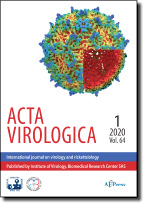Acta Virologica Vol.58, No.3, p.199-213, 2014
|
| Title: Human parvovirus B19: A review |
| Author: L. D. ROGO, T. MOKHTARI-AZAD, M. H. KABIR, F. REZAEI |
|
Abstract: Parvovirus B19 (B19V) is a small non-enveloped single-stranded DNA (ssDNA) virus of the family Parvoviridae, the subfamily Parvovirinae, the genus Erythrovirus and Human parvovirus B19 type species. It is a common community-acquired respiratory pathogen without ethnic, socioeconomic, gender, age or geographic boundaries. Moreover, the epidemiological and ecological relationships between human parvovirus B19, man and environment have aroused increasing interest in this virus. B19V infection is associated with a wide spectrum of clinical manifestations, some of which were well established and some are still controversial, however, it is also underestimated from a clinical perspective. B19V targets the erythroid progenitors in the bone marrow by binding to the glycosphingolipid globoside (Gb4), leading to large receptor-induced structural changes triggering cell death either by lysis or by apoptosis mediated by the nonstructural (NS)1 protein. The pattern of genetic evolution, its peculiar properties and functional profile, the characteristics of its narrow tropism and restricted replication, its complex relationship with the host and its ample pathogenetic potential are all topics that are far from a comprehensive understanding. The lack of efficient adaptation to in vitro cellular cultures and the absence of animal models have limited classical virological studies and made studies on B19V dependent on molecular biology. The present review looks at the nature of this virus with the view to provide more information about its biology, which may be useful to the present and future researchers.
|
|
| Keywords: human parvovirus B19; respiratory pathogen; biology; genome; fifth disease; transient aplastic crisis; anemia |
|
|
|
| Year: 2014, Volume: 58, Issue: 3 |
Page From: 199, Page To: 213 |
doi:10.4149/av_2014_03_199
|
|
 download file download file |
|
|
|
|
 download file
download file
